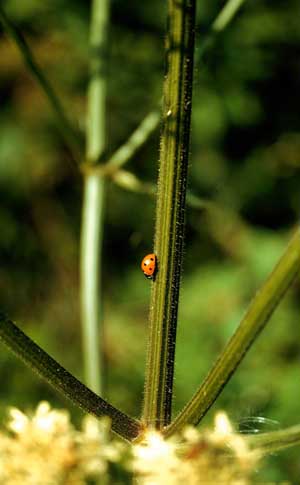|
|
 31 ladybird beetle DHJanzen100193.jpg high resolution
|
|
| And these interactions do not occur only in the tropics. Here is a familiar ladybird beetle (Coccinellidae) that could be in your back yard. Its bright red color warns of noxious defensive chemicals that it makes for itself. The larva and adult are predators, and do not feed on plants (a potential source of noxious chemicals), though that does not totally eliminate the possibility that they do not sequester defensive chemicals from their prey. Imagine a young warbler growing up in a Michigan summer, learning quickly not to eat such a bright red beetle, and then flying to Panama for the winter, where it encounters many bright red beetles (such as the alticid chrysomelid in DHJanzen100194.jpg). It is highly doubtful that it starts all over again learning the lesson just because it is in a different habitat. Furthermore, given that the bird is exposed to hundreds of species of red/orange/yellow ostentatious (behaving) models as it goes through its life in many habitats, and only occasionally a mimic if it is sampling (learning, re-learning) it seems very likely that it simply generalizes and for the rest of its life does not attempt to prey on these aposematic insects. But, do remember the monarch being carefully and selectively fed upon by birds in its overwintering site, a place where the monarchs are the dominant potential food for small insectivorous birds. | ||
back to lecture slides
or skip to: